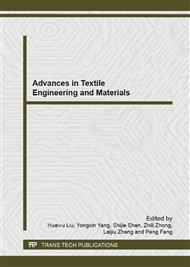p.239
p.243
p.248
p.252
p.258
p.263
p.267
p.271
p.275
The Fabrics Magnetic Coating Finishing Explore
Abstract:
The topics chosen Fe3O4 and r-Fe2O3 nano-magnetic particle, respectively, with polyurethane and polyacrylate mixed ,mixed evenly coated on the surface of the fabric, then on before and after coating fabric tensile properties, tear resistance mechanical properties tested and compared. Experimental results show that: the choice of Fe3O4 better than r-Fe2O3 remanence effects, selection polyacrylate better softness than the selection of polyurethane, the latitude and longitude to the breaking strength was increased in the magnetic coating of the fabric, while the tear strength and abrasion resistance were reduced .
Info:
Periodical:
Pages:
258-262
Citation:
Online since:
December 2012
Authors:
Price:
Сopyright:
© 2013 Trans Tech Publications Ltd. All Rights Reserved
Share:
Citation:


